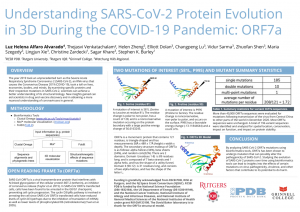Alfaro, Luz: Understanding SARS-CoV-2 Protein Evolution in 3D During the COVID-19 Pandemic: ORF7a
Title: Understanding SARS-CoV-2 Protein Evolution in 3D During the COVID-19 Pandemic: ORF7a
Name: Luz Alfaro
Home Institute: Grinnell College
Programs: RISE program, Protein Data Bank
Other contributors: Thejasvi Venkatachalam (Rutgers University), Helen Zheng (Watchung Hills Regional) Elliott Dolan, Changpeng Lu, Vidur Sarma, Zhuofan Shen, Maria Szegedy, Lingjun Xie (IQB) Christine Zardecki (RCSB PDB, IQB) Sagar Khare (IQB) Stephen K. Burley (RCSB PDB, IQB)
Abstract: The year 2019 and 2020 took an unprecedented turn as SARS-CoV-2 (COVID-19) ravaged the world, taking over half a million lives (as of July 2020), leaving vulnerable communities to take the hardest hits, exacerbating systemic injustices towards minorities (including decreased access to healthcare), and damaging economies. By examining proteins and their respective mutations in SARS-CoV-2, a better understanding of its structural biology can aid in drug and vaccine discovery. Further applications of a deepened structural understanding of SARS-CoV-2 include assisting in broader research efforts and valuable public health efforts to mitigate and prevent harm caused by SARS-CoV-2 and other coronaviruses worldwide.
As part of a virtual summer research experience with the RCSB PDB, we studied how SARS-CoV-2 proteins protein evolved during the first six months of the COVID-19 pandemic by exploring amino acid sequence and 3D atomic-level structure using various structural bioinformatics tools, including Clustal Omega (www.ebi.ac.uk/Tools/msa/clustalo/) for sequence alignments and phylogenetic trees; Mol* (molstar.org) for 3D molecular visualization; and Foldit (fold.it) for structural/energetic effects of sequence mutations.
The focus of this poster is SARS-CoV-2 Orf7a, a viral protein that in SARS-CoV interferes with N-linked glycosylation of the cellular protein BST-2, an inhibitor of coronavirus release (Taylor et al. 2015). Orf7a has also been shown to arrest cells in the G0/G1 cell checkpoint during SARS-CoV infection, thereby preventing cell cycle progression. Prevention of cell cycle progression is thought to provide more time for coronaviruses to replicate at higher rates with increased nucleotide pools and allow for higher virus pathogenicity (Yuan et al. 2005). Studying Orf7a can provide insights into SARS-CoV-2 pathogenesis, including what proteins are involved in regulating viral propagation and what SARS-CoV-2 proteins affect host cell cycle regulation.
Biography: Hello! My name is Luz Helena Alfaro (she/her/hers) and I am a rising 3rd year Sociology major at Grinnell College in Iowa. I was born and raised in Elizabeth, NJ where I am currently residing. A few of my interests include social issues, public health, science communication, structural biology, biochemistry, art, and traveling. Participating in the 2020 RISE cohort has been nothing less than spectacular. I have been able to learn new skills, be part of a wonderful community of supportive scholars, and find new passions. As an individual who loves interdisciplinary activities and variety (variety is the spice of life), I thrive when doing collaborative research that has valuable impacts on communities. One of my life aims is to always strive to be a socially responsible global citizen. Currently, I am planning to pursue an MD-PhD degree to connect two of my most important passions, medicine and research. I hope to be a student wherever I am for the rest of my life and to positively impact those around me in a sustainable and healthy manner.
